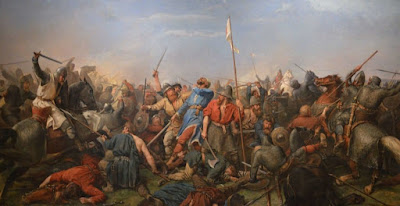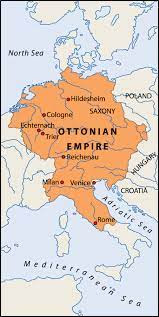It is true that the queens of Mercia seem to have a notable amount of authority compared to other royal women—in fact, Cynethryth of Mercia, wife of King Offa, even had her own coinage with her image on it!—but was she actually as terrible and bloodthirsty as we are told?
We don't know anything about her or her parentage until 770, when her name appears as a witness on a charter. The similarity of her name to that of the wife and daughters of King Penda (c.606 - 655) of Mercia (Cynewise, Cyneburh, Cyneswith) suggests she was of that line, which would make her a distant relative of Offa.
The Vitae duorum Offarum ("The lives of the two Offas") relates and compares the stories of the 4th or 5th century Offa of Angel and the Offa of Mercia who reigned in the second half of the 8th century and was married to Cynethryth. Originally thought to be composed by Matthew Paris, it is now thought to be an earlier work. Of Cynethryth, the Vitae calls her "Drida," and that she was Frankish and condemned for some crime to be set adrift at sea. She drifts to the Welsh shore where she is found and brought before Offa. She claims to be a member of Carolingian royalty, and Offa puts her in the care of his mother, Marcellina. Offa eventually falls in love and marries her, after which she changes her name from Drida to Quindrida (from Thryth to Cynethryth).
The minting of coins in her likeness tells us a lot about how much authority Offa gave her. In one of his letter, Alcuin refers to Cynethryth as "controller of the Royal household." The marriage seemed to be a steady one. Alcuin, writing to their son Ecgfrith, advised him to follow the example of his parents, and comments on her piety.
What the crime was that originally caused her to be set adrift, we'll never know. Æthelberht II, King of East Anglia and Alfred the Great's older brother (died 20 May 794) is said to have been assassinated by Offa. Later chroniclers suggest that Cynethryth was more involved. This may be simply because of the earlier tale of her coming into the picture as an exiled criminal. There are no specifics or evidence that she was inciting executions or assassinations.
It is not unknown, however, that early kings would kill off even relatives in order to make succession clear and avoid attempts at usurpation of civil war. When Offa's and Cynethryth's only son, Ecgfrith, reigned a mere 141 days, the only heir to the throne of Mercia was a very distant relive, Coenwulf, because nearer relatives had been eliminated by Offa. Alcuin himself acknowledged this, writing:
That most noble young man has not died for his sins, but the vengeance for the blood shed by the father has reached the son. For you know how much blood his father shed to secure the kingdom upon his son. ... This was not a strengthening of the kingdom, but its ruin.
The last reference we have to Cynethryth was in 798, when she was present at the Synod of Clovesho in a dispute regarding the monastery at Cookham. I'll explain her connection to that dispute, and talk about the Synods, next time.




























